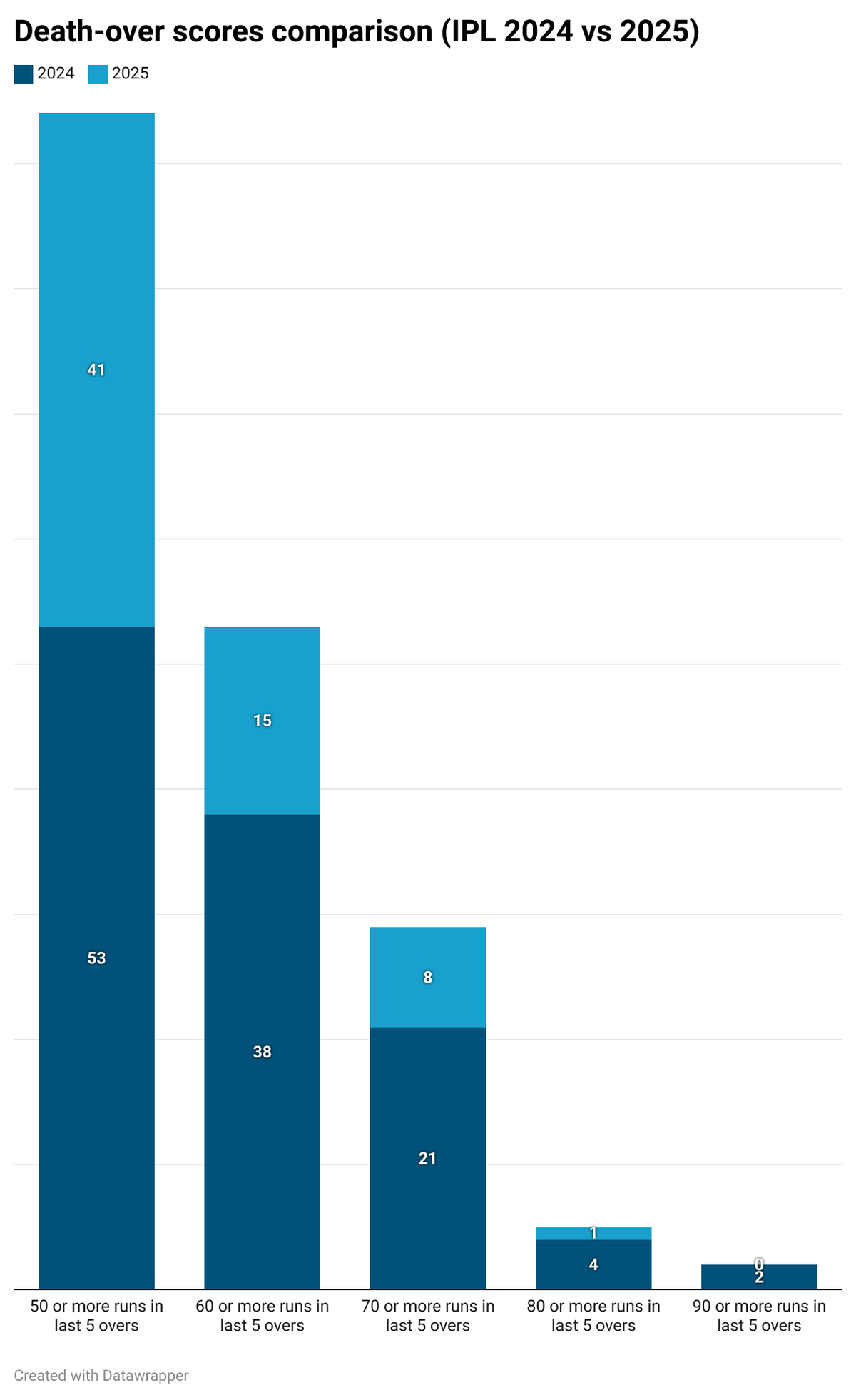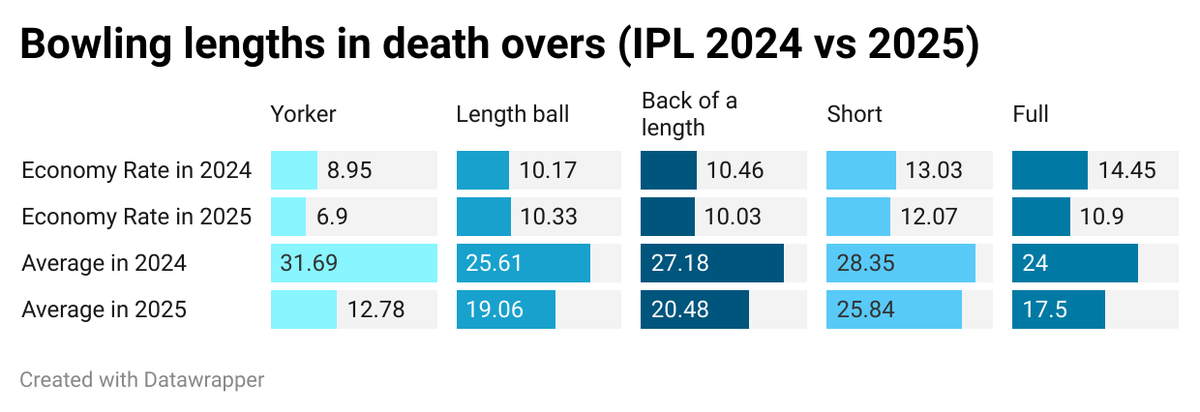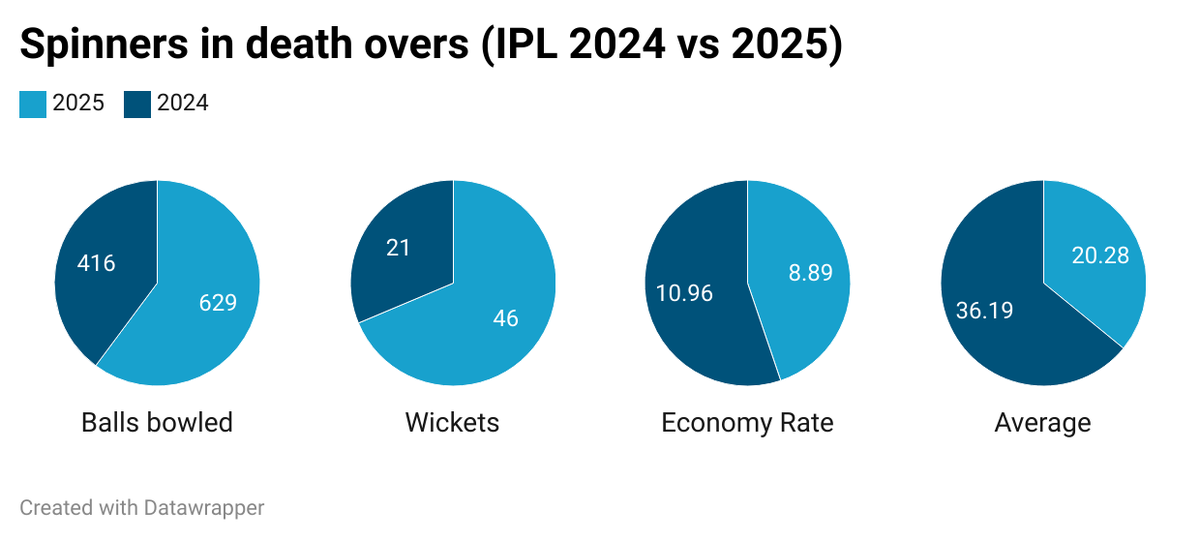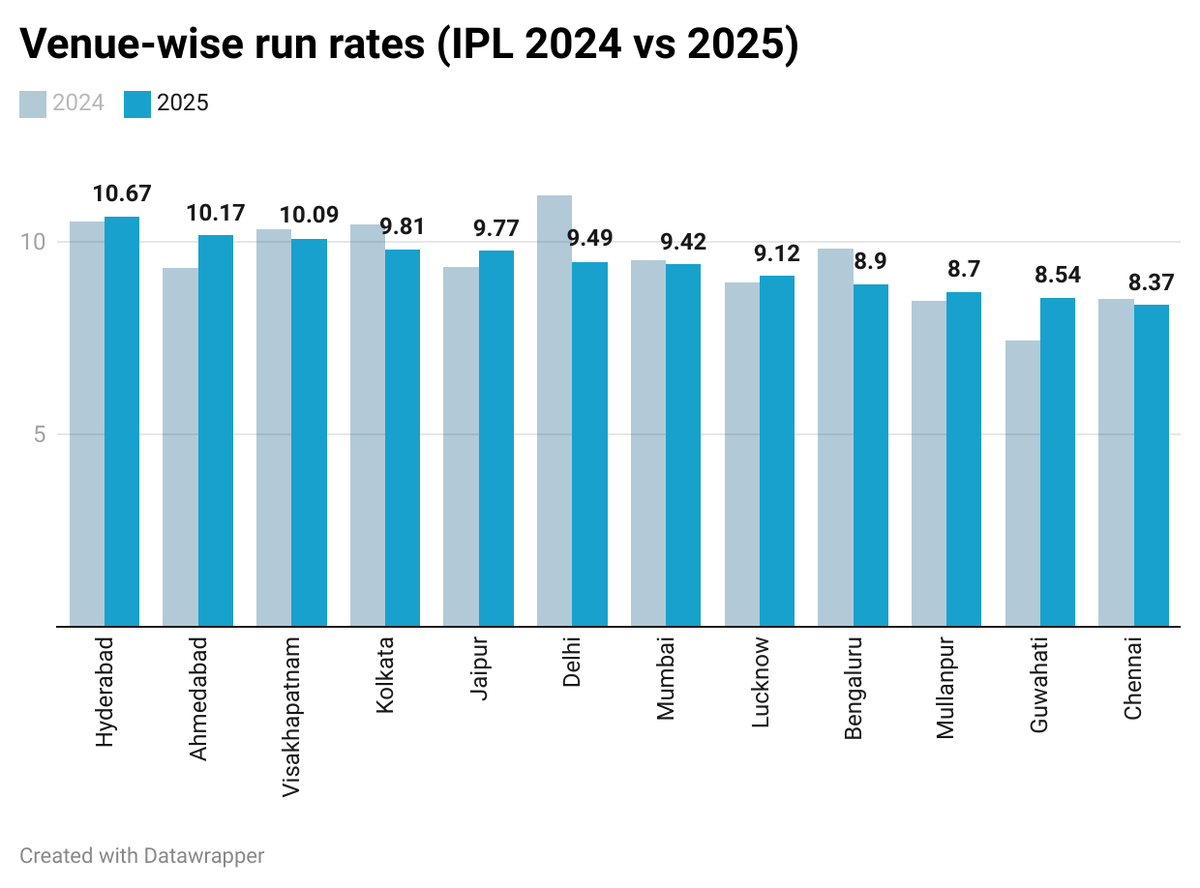In the wake of a record-breaking 2024 season, where batters plundered runs at an unprecedented rate, the Indian Premier League (IPL) entered 2025 bracing for even more stratospheric standards. An ultra-aggressive brand of batting had become the norm, and the race for the league’s first-ever 300-plus total was well and truly on — it felt like only a matter of time.
Expectedly, Sunrisers Hyderabad came frighteningly close to it in the second match of the season, ransacking 286 in a run-fest against Rajasthan Royals. However, 50 matches into the season, no team has breached the 250-run mark since, and Sunrisers are languishing towards the bottom of the standings.
There was a 6.34 per cent increase in scoring rates from 2023 to 2024, with the IPL ushering in the Impact Player era. However, that upward swing didn’t sustain, and the bowlers found a way to remain relevant.
On the face of it, the overall run rate (9.41) in the ongoing season (after 50 matches) is just a shade lower than last year (9.56). Still, there seems to be a more judicious balance between bat and ball in 2025, perhaps because the runs are more evenly spread out. Eight of the tournament’s 10 highest team totals were registered in 2024, while 2025 has a solitary entry on that list. The total number of sixes after 50 games has dropped from 903 in 2024 to 833 in 2025; the fours have reduced from 1553 to 1522, and while the tally of 50-plus individual scores is level at 111, this season has witnessed just four centuries after 50 games, compared to 11 in 2024.

The difference in run rates in the PowerPlay and middle overs (7 to 15) between 2024 and 2025 is negligible, but the scoring rate in the death overs (16 to 20) has witnessed a steeper dip, falling from 11.55 to 10.69. If a decline of 0.86 runs per over doesn’t seem significant, consider this. After 50 matches in 2024, teams had plundered 60 runs or more in the last five overs on 38 occasions. In 2025, that number has plunged to just 15 in the corresponding period.
Consequently, the number of batters who excel during this crucial phase of the innings has dwindled. In 2024, 13 batters had scored more than 100 runs (minimum 50 balls faced) in the last five overs, while 10 boasted of a strike rate in excess of 175. Those numbers have dropped to eight and five, respectively, this season. The likes of Heinrich Klaasen, Rishabh Pant and Andre Russell have failed to replicate their ball-striking ability in 2025. While the indifferent form of some of the league’s most explosive batters hasn’t helped, the bowlers, aided by changes in playing conditions, have also stepped up and recalibrated their plans.

Full and straight at the death
With reverse-swing coming back into the scheme of things, partially owing to the lifting of the ban on applying saliva on the ball, the menace of the yorker has also returned. While it was the most potent weapon in the death overs last season, costing 8.95 runs an over and producing a wicket almost every 32 balls, its efficacy has drastically increased. In 2025, between overs 16 and 20, the yorker has conceded just 6.90 runs an over and averages a stunning 12.78 runs per wicket – the best for any length during this phase of the innings. Interestingly, in 2024, the yorker had the worst average (31.69) amongst all the other lengths bowled during this phase of the innings.
The bowlers have also executed the full deliveries — considered easy pickings for batters — with greater accuracy and efficiency. The run rate against full deliveries in the death overs has dropped from 14.45 in 2024 to 10.90 in 2025, while the average runs conceded per wicket has also fallen from 24 to 17.5.
Gujarat Titans’ death-overs specialist batter Shahrukh Khan acknowledged the role of a drier ball and reverse-swing in stemming the flow of runs towards the back end of the innings.
“The ball has been changed after 15 overs… Reverse-swing comes into play, and when the ball is dry, it is not that easy for the batsmen to go after the bowlers. Death [overs] batting has not been that easy. You need to be really skilful to get the ball out of the rope. In the previous years, the ball got wet, and execution was a lot tougher,” he said.
Bowling fuller and straighter has also proven to be more effective this season. Deliveries in line of the stumps went at 10.60 runs an over at the death in 2024, while in 2025 that number has dropped to 9.29. Straighter deliveries have also become a better wicket-taking preposition, with their average dropping from 22.73 runs per wicket in 2024 to 15.79 in 2025.

In a tailspin
The death overs have also seen the resurgence of spinners in 2025. They have been more frequently employed in the last five overs this season, and their effectiveness has doubled. Their wickets tally in overs 16 to 20 has swelled from 21 in 2024 to 46 in 2025, and their ability to contain has also increased considerably, with their economy rate dropping from 10.96 to 8.89 during this phase of the innings.
The spinners have made their presence felt particularly in the 16th over, when the batters are setting the launchpad for a death-overs charge. At this critical juncture, the spinners have picked 18 wickets this season, compared to nine last year, at an economy rate of 8.33 and an average of 20.83.
Queering the pitch
In six of the 12 venues used so far in IPL 2025, the run rates have dropped in comparison to last season. Delhi’s Arun Jaitley Stadium and Bengaluru’s M. Chinnaswamy Stadium have seen the sharpest decline, with run rates dropping from 11.20 to 9.49 and 9.84 to 8.90, respectively. Meanwhile, among venues that have hosted at least four matches this season, Ahmedabad is the only one that has seen a noticeable jump in run rate — an increase of 0.83 runs an over.
The improved returns for spinners on traditionally batting-friendly surfaces have largely driven this turnaround. In Delhi, the spinners have conceded eight runs an over on average, compared to 10.28 last season, while their average has improved from 29.68 to 23.53. Similarly, in Bengaluru, the tweakers have an economy rate of 8.22 this year, compared to 8.98 in 2024, while their average has improved by more than 10 runs per wicket, dropping to 32.42 from 42.66.
The other venues that have witnessed a marginal dip in overall run rates are Wankhede Stadium in Mumbai (9.54 to 9.42), Kolkata’s Eden Gardens (10.47 to 9.81), M.A. Chidambaram Stadium in Chennai (8.52 to 8.37), and ACA-VDCA Cricket Stadium in Visakhapatnam (10.34 to 10.09).

Beyond the PowerPlay
The inability of certain teams to adapt to conditions has also led to stagnating run rates this season. A case in point is Sunrisers Hyderabad, an outlier last season which turbocharged scoring rates with consistent onslaughts in the PowerPlay. It struck at a whopping 11.17 in the first six overs in 2024, followed by defending champion Kolkata Knight Riders (11.07) and Delhi Capitals (10.67). None of these teams have managed to replicate that ball-striking ability this season, with KKR and DC unable to find the right combination and the famed duo of Abhishek Sharma and Travis Head far from their marauding best.
SRH seamer Jaydev Unadkat attributed his side’s falling stocks to tougher pitches and acknowledged that bowlers and their plans are constantly evolving.
“Last year, we scored 200-plus in four or five [six] matches, and that gave us a sense that we had set a standard. But that can’t always be the norm. Other teams and batters are planning better now, and bowlers are also adapting and coming up with new strategies. Last year, swing was enough to make an impact, but this year, it’s about using variations effectively. Also, the pitches are playing a big role. Last year we had a lot of flat pitches, whereas this time we’ve had more difficult ones,” he said.
Bowlers have used the pitch more and relied on swing less in the PowerPlay this year. The number of full deliveries has reduced by over 40 per cent compared to 2024, while the short and back-of-a-length deliveries have increased by 11.13 per cent and 37.14 per cent, respectively.
The PowerPlay run rates may have only dipped marginally between 2024 and 2025, from 9.46 to 9.44, but the bowlers have managed to avoid astronomical totals in the first six overs. Five of the top 10 PowerPlay scores in IPL history were set in 2024, while only two from 2025 have made it to that list so far.

Bowlers in the ascendancy?
In IPL 2024, the tournament’s two most aggressive batting units — Sunrisers Hyderabad and Kolkata Knight Riders — had reached the final.
Despite IPL 2025 almost matching last season’s scoring rates, the better bowling attacks are dominating this year. Mumbai Indians and Royal Challengers Bengaluru, the most economical sides after 50 matches, are first and second, respectively, in the standings.
And that has been the beauty of this season: while the batters flirt with unscaled heights, the bowlers keep them grounded.

